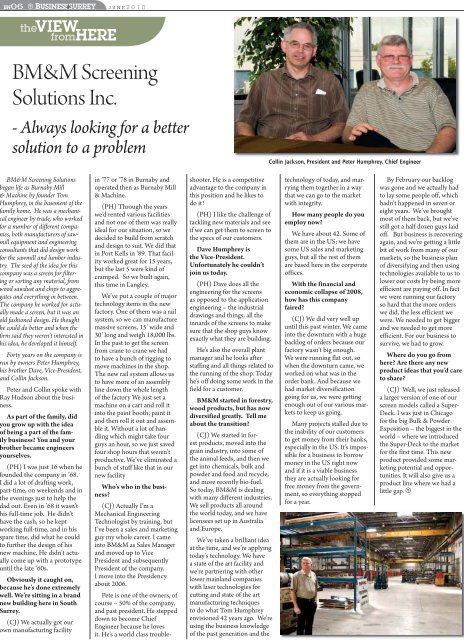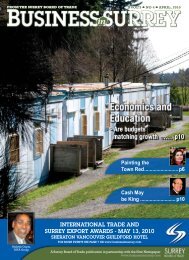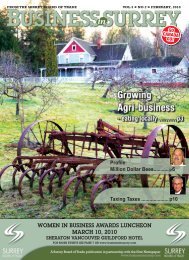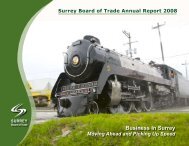2010 annual general meeting june 24, 2010 - Surrey Board of Trade
2010 annual general meeting june 24, 2010 - Surrey Board of Trade
2010 annual general meeting june 24, 2010 - Surrey Board of Trade
You also want an ePaper? Increase the reach of your titles
YUMPU automatically turns print PDFs into web optimized ePapers that Google loves.
BN06<br />
theVIEW fromHERE<br />
JUNE<strong>2010</strong><br />
BM&M Screening<br />
Solutions Inc.<br />
- Always looking for a better<br />
solution to a problem<br />
Collin Jackson, President and Peter Humphrey, Chief Engineer<br />
BM&M Screening Solutions<br />
egan life as Burnaby Mill<br />
Machine by founder Tom<br />
umphrey, in the basement <strong>of</strong> the<br />
amily home. He was a mechanial<br />
engineer by trade, who worked<br />
or a number <strong>of</strong> different compaies,<br />
both manufacturers <strong>of</strong> sawill<br />
equipment and engineering<br />
onsultants that did design work<br />
or the sawmill and lumber indusry.<br />
The seed <strong>of</strong> the idea for this<br />
ompany was a screen for filterng<br />
or sorting any material, from<br />
ood sawdust and chips to aggreates<br />
and everything in between.<br />
he company he worked for actully<br />
made a screen, but it was an<br />
ld fashioned design. He thought<br />
e could do better and when the<br />
irm said they weren’t interested in<br />
is idea, he developed it himself.<br />
Forty years on the company is<br />
un by owners Peter Humphrey,<br />
is brother Dave, Vice-President,<br />
nd Collin Jackson.<br />
Peter and Collin spoke with<br />
ay Hudson about the busiess.<br />
As part <strong>of</strong> the family, did<br />
ou grow up with the idea<br />
f being a part <strong>of</strong> the famly<br />
business? You and your<br />
rother became engineers<br />
ourselves.<br />
(PH) I was just 16 when he<br />
ounded the company in ’68.<br />
did a lot <strong>of</strong> drafting work,<br />
art-time, on weekends and in<br />
he evenings just to help the<br />
ad out. Even in ’68 it wasn’t<br />
is full-time job. He didn’t<br />
ave the cash, so he kept<br />
orking full-time, and in his<br />
pare time, did what he could<br />
o further the design <strong>of</strong> his<br />
ew machine. He didn’t actully<br />
come up with a prototype<br />
ntil the late ‘60s.<br />
Obviously it caught on,<br />
ecause he’s done extremely<br />
ell. We’re sitting in a brand<br />
ew building here in South<br />
urrey.<br />
(CJ) We actually got our<br />
wn manufacturing facility<br />
in ’77 or ’78 in Burnaby and<br />
operated then as Burnaby Mill<br />
& Machine.<br />
(PH) Through the years<br />
we’d rented various facilities<br />
and not one <strong>of</strong> them was really<br />
ideal for our situation, so we<br />
decided to build from scratch<br />
and design to suit. We did that<br />
in Port Kells in ’89. That facility<br />
worked great for 15 years,<br />
but the last 5 were kind <strong>of</strong><br />
cramped. So we built again,<br />
this time in Langley.<br />
We’ve put a couple <strong>of</strong> major<br />
technology items in the new<br />
factory. One <strong>of</strong> them was a rail<br />
system, so we can manufacture<br />
massive screens, 15’ wide and<br />
30’ long and weigh 18,000 lbs.<br />
In the past to get the screen<br />
from crane to crane we had<br />
to have a bunch <strong>of</strong> rigging to<br />
move machines in the shop.<br />
The new rail system allows us<br />
to have more <strong>of</strong> an assembly<br />
line down the whole length<br />
<strong>of</strong> the factory We just set a<br />
machine on a cart and roll it<br />
into the paint booth, paint it<br />
and then roll it out and assemble<br />
it. Without a lot <strong>of</strong> handling<br />
which might take four<br />
guys an hour, so we just saved<br />
four shop hours that weren’t<br />
productive. We’ve eliminated a<br />
bunch <strong>of</strong> stuff like that in our<br />
new facility<br />
Who’s who in the business?<br />
(CJ) Actually I’m a<br />
Mechanical Engineering<br />
Technologist by training, but<br />
I’ve been a sales and marketing<br />
guy my whole career. I came<br />
into BM&M as Sales Manager<br />
and moved up to Vice<br />
President and subsequently<br />
President <strong>of</strong> the company.<br />
I move into the Presidency<br />
about 2006.<br />
Pete is one <strong>of</strong> the owners, <strong>of</strong><br />
course – 50% <strong>of</strong> the company,<br />
and past president. He stepped<br />
down to become Chief<br />
Engineer because he loves<br />
it. He’s a world class troubleshooter.<br />
He is a competitive<br />
advantage to the company in<br />
this position and he likes to<br />
do it!<br />
(PH) I like the challenge <strong>of</strong><br />
tackling new materials and see<br />
if we can get them to screen to<br />
the specs <strong>of</strong> our customers.<br />
Dave Humphrey is<br />
the Vice-President.<br />
Unfortunately he couldn’t<br />
join us today.<br />
(PH) Dave does all the<br />
engineering for the screens<br />
as opposed to the application<br />
engineering – the industrial<br />
drawings and things, all the<br />
innards <strong>of</strong> the screens to make<br />
sure that the shop guys know<br />
exactly what they are building.<br />
He’s also the overall plant<br />
manager and he looks after<br />
staffing and all things related to<br />
the running <strong>of</strong> the shop. Today<br />
he’s <strong>of</strong>f doing some work in the<br />
field for a customer.<br />
BM&M started in forestry,<br />
wood products, but has now<br />
diversified greatly. Tell me<br />
about the transition?<br />
(CJ) We started in forest<br />
products, moved into the<br />
grain industry, into some <strong>of</strong><br />
the animal feeds, and then we<br />
get into chemicals, bulk and<br />
powder and food and recycle,<br />
and more recently bio-fuel.<br />
So today, BM&M is dealing<br />
with many different industries.<br />
We sell products all around<br />
the world today, and we have<br />
licensees set up in Australia<br />
and Europe.<br />
We’ve taken a brilliant idea<br />
at the time, and we’re applying<br />
today’s technology. We have<br />
a state <strong>of</strong> the art facility and<br />
we’re partnering with other<br />
lower mainland companies<br />
with laser technologies for<br />
cutting and state <strong>of</strong> the art<br />
manufacturing techniques<br />
to do what Tom Humphrey<br />
envisioned 42 years ago. We’re<br />
using the business knowledge<br />
<strong>of</strong> the past generation and the<br />
technology <strong>of</strong> today, and marrying<br />
them together in a way<br />
that we can go to the market<br />
with integrity.<br />
How many people do you<br />
employ now?<br />
We have about 42. Some <strong>of</strong><br />
them are in the US; we have<br />
some US sales and marketing<br />
guys, but all the rest <strong>of</strong> them<br />
are based here in the corporate<br />
<strong>of</strong>fices.<br />
With the financial and<br />
economic collapse <strong>of</strong> 2008,<br />
how has this company<br />
faired?<br />
(CJ) We did very well up<br />
until this past winter. We came<br />
into the downturn with a huge<br />
backlog <strong>of</strong> orders because our<br />
factory wasn’t big enough.<br />
We were running flat out, so<br />
when the downturn came, we<br />
worked on what was in the<br />
order bank. And because we<br />
had market diversification<br />
going for us, we were getting<br />
enough out <strong>of</strong> our various markets<br />
to keep us going.<br />
Many projects stalled due to<br />
the inability <strong>of</strong> our customers<br />
to get money from their banks,<br />
especially in the US. It’s impossible<br />
for a business to borrow<br />
money in the US right now<br />
and if it is a viable business<br />
they are actually looking for<br />
free money from the government,<br />
so everything stopped<br />
for a year.<br />
By February our backlog<br />
was gone and we actually had<br />
to lay some people <strong>of</strong>f, which<br />
hadn’t happened in seven or<br />
eight years. We’ve brought<br />
most <strong>of</strong> them back, but we’ve<br />
still got a half dozen guys laid<br />
<strong>of</strong>f. But business is recovering<br />
again, and we’re getting a little<br />
bit <strong>of</strong> work from many <strong>of</strong> our<br />
markets, so the business plan<br />
<strong>of</strong> diversifying and then using<br />
technologies available to us to<br />
lower our costs by being more<br />
efficient are paying <strong>of</strong>f. In fact<br />
we were running our factory<br />
so hard that the more orders<br />
we did, the less efficient we<br />
were. We needed to get bigger<br />
and we needed to get more<br />
efficient. For our business to<br />
survive, we had to grow.<br />
Where do you go from<br />
here? Are there any new<br />
product ideas that you’d care<br />
to share?<br />
(CJ) Well, we just released<br />
a larger version <strong>of</strong> one <strong>of</strong> our<br />
screen models called a Super-<br />
Deck. I was just in Chicago<br />
for the big Bulk & Powder<br />
Exposition – the biggest in the<br />
world – where we introduced<br />
the Super-Deck to the market<br />
for the first time. This new<br />
product provided some marketing<br />
potential and opportunities.<br />
It will also give us a<br />
product line where we had a<br />
little gap.








